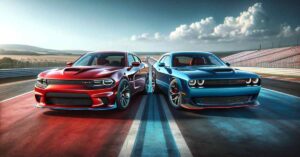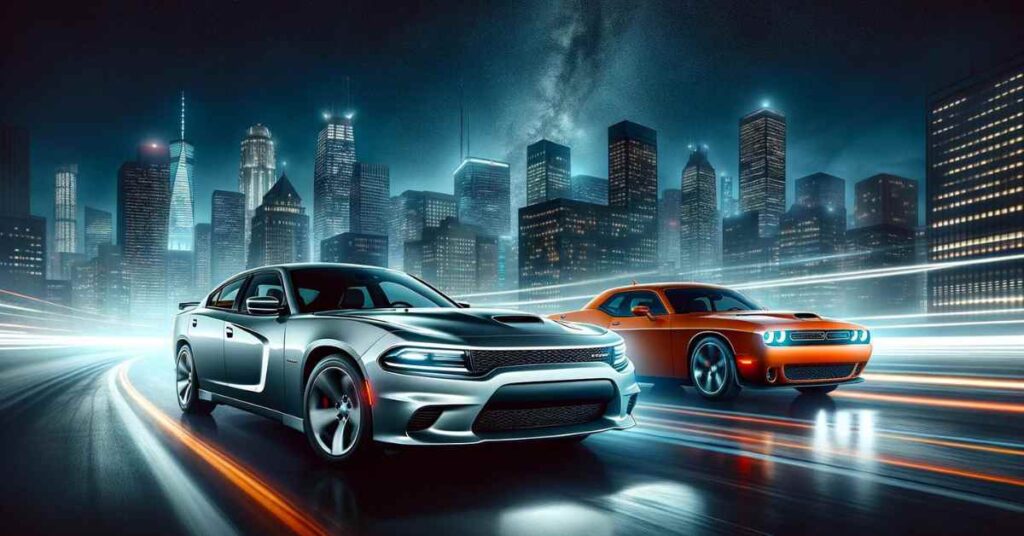Introduction to Muscle Car Legends
Muscle cars have captivated automotive enthusiasts for decades with their roaring engines, aggressive styling, and undeniable presence on the road. Among the pantheon of these powerful vehicles, the Dodge Charger vs Dodge Challenger stand out as iconic symbols of American muscle. This article will explore these two legendary cars, delving into their history, design, performance, and much more to help you understand which might be the right choice for you.
Historical Overview of Dodge Charger vs Challenger
The Dodge Charger vs Challenger have been at the heart of the muscle car scene since their inception. The Charger first hit the streets in the mid-1960s, initially as a show car. It quickly evolved into a full-fledged production model that became synonymous with power and performance. Over the years, it has undergone several transformations, each enhancing its appeal and capabilities.
On the other hand, the Challenger emerged a few years later, in the early 1970s, as Dodge’s answer to competitors like the Ford Mustang and Chevrolet Camaro. It was designed to be a more substantial and luxurious option in the muscle car category, offering a wide range of engine options and trim levels. The Challenger’s retro design cues, even in modern versions, pay homage to its illustrious past.
Design and Aesthetics
The Evolution of the Dodge Charger
The Dodge Charger’s design has been a journey of transformation, blending old-school charm with modern sleekness. Initially, the Charger boasted a full-size two-door body style with a distinct fastback look, which was quite popular in the muscle car era. Over time, the Charger morphed into a four-door sedan, yet it retained its muscular essence. Today’s Chargers come with a bold front grille, scalloped body sides, and a design that hints at its storied past while embracing a more contemporary aesthetic.
Classic vs. Modern Designs
The classic Chargers of the 1960s and 70s featured prominent round headlights and a straightforward, aggressive stance that screamed speed and power. In contrast, modern Chargers showcase sharper lines, LED lighting, and aerodynamic enhancements that speak to advanced engineering and a focus on performance. Despite these changes, Dodge has managed to keep the Charger’s soul alive, ensuring that it continues to be a favorite among muscle car lovers.
The Distinct Look of the Dodge Challenger
The Dodge Challenger is perhaps the best example of a muscle car that has embraced its heritage without compromise. Its design closely mirrors the original 1970s models, with a long hood, short deck, and wide stance that are instantly recognizable. The modern Challenger has been careful to maintain the nostalgic elements, such as the round front headlights and the classic, bold taillight arrangement.
Retaining the Retro Vibe
Unlike the Charger, the Challenger has not strayed far from its roots in terms of appearance. This dedication to its retro vibe is a significant selling point, as it offers a direct connection to the golden age of muscle cars. The Challenger’s body, with its pronounced wheel arches and minimalistic trim, offers a pure, undiluted muscle car experience, enhanced by modern touches like LED lighting and customizable options that allow owners to personalize their ride.
Performance and Power
Engine Specifications of the Dodge Charger
The Dodge Charger is not just about looks; its performance on the road is equally impressive. The range of engines available for the Charger is extensive, from the more economical V6 engines that provide a balance of power and efficiency, to the thunderous V8 HEMI engines that deliver the raw power muscle car enthusiasts crave. The Charger’s top-tier models, like the SRT Hellcat, come equipped with a supercharged 6.2-liter HEMI V8, producing an astonishing 707 horsepower.
Comparing V6 and V8 Options
For those looking for a daily driver, the Charger’s V6 options are more than sufficient, offering over 300 horsepower with better fuel efficiency. However, for the true muscle car experience, the V8 models are where the Charger shines. Even the base V8 delivers a hefty 370 horsepower, with options climbing to the supercharged extremes of the Hellcat and beyond. This range makes the Charger versatile, capable of meeting various needs and preferences.
Dodge Challenger’s Performance Features
The Challenger, much like the Charger, offers a broad spectrum of engine choices. The base model starts with a competent V6 engine, but the real excitement begins with the V8 options, particularly the 5.7-liter and 6.4-liter HEMI engines. These engines provide a thrilling blend of sound, power, and performance, with the Challenger SRT Hellcat and the even more extreme Demon models pushing the limits of what a factory-produced muscle car can achieve.
Hellcat and Beyond: Top Models
The Challenger’s Hellcat variant is a beast, boasting over 700 horsepower from its supercharged 6.2-liter V8. The Demon model, however, takes things to another level with 840 horsepower under specific conditions, making it one of the most powerful production cars ever. These high-performance models are not just about straight-line speed; they come equipped with upgraded brakes, suspension, and aerodynamic elements to handle the immense power.

Handling and Driving Experience
How the Charger Handles the Road
The Dodge Charger, despite its larger size and four-door configuration, offers a surprisingly agile driving experience. It’s equipped with a responsive steering system and a suspension that can be tuned from comfortable to sporty, depending on the model and settings. The higher trims, particularly those with performance packages, feature enhancements like adaptive dampers and performance-oriented suspension setups, allowing for a firmer and more controlled ride that makes the Charger feel at home on both highways and winding roads.
Comfort vs. Sportiness
For everyday driving, the Charger provides a balanced ride that leans more towards comfort, especially in models with the V6 engine. However, when equipped with sportier trims and the V8 engines, the Charger transforms, offering a more dynamic and engaging drive. The ability to switch between different driving modes further enhances this versatility, making it possible to enjoy a smooth, quiet ride one moment and a spirited, high-performance experience the next.
The Challenger’s Drive Feel
The Dodge Challenger, with its classic muscle car proportions and heavier build, prioritizes straight-line acceleration and a commanding road presence. Its handling is robust and predictable, with a focus on delivering a powerful driving experience that resonates with the muscle car ethos. The Challenger’s rear-wheel-drive layout and available all-wheel drive in certain models ensure solid traction and control, especially in powerful versions.
Track Capabilities and Everyday Driving
While the Challenger shines on the drag strip thanks to its raw power and acceleration, it also manages to offer a surprisingly comfortable ride for daily use. The suspension is tuned to absorb road imperfections, providing a smooth ride that belies its aggressive appearance. For those looking to push the limits, track-oriented versions like the SRT Hellcat and the Demon are equipped with features that enhance performance on the circuit, such as track modes, high-performance tires, and specialized aerodynamic components.
Interior and Technology
Modern Amenities in the Charger
Inside, the Dodge Charger marries muscle car aesthetics with modern comforts and technology. The interior boasts a driver-oriented cockpit with intuitive controls, comfortable seating, and quality materials, especially in higher trims. Technology is a key focus, with features like a large touchscreen infotainment system that supports Apple CarPlay and Android Auto, advanced driver assistance systems, and customizable digital displays that allow drivers to monitor performance metrics in real-time.
Infotainment and Comfort
The Charger’s infotainment system is among the best in its class, offering easy navigation, responsive controls, and a wealth of connectivity options. Comfort is not sacrificed for performance; even the most potent Chargers come with supportive seats, dual-zone climate control, and options for premium audio systems, ensuring that both driver and passengers can enjoy the ride in style and comfort.
Challenger’s Cabin and Tech Upgrades
The Dodge Challenger’s interior holds true to its retro-inspired exterior, with a layout that echoes the classic muscle cars while incorporating modern touches. The seats are wide and supportive, suitable for long drives, and the overall cabin space is generous, particularly for a performance car. Technology in the Challenger is similarly up-to-date, with a comprehensive infotainment system, digital instrument cluster, and a range of audio and connectivity features.
Balancing Muscle with Modernity
In the Challenger, the blend of old and new is seamless, offering drivers the nostalgic feel of a muscle car with the conveniences of contemporary vehicles. From keyless entry and start to heated and ventilated seats, the Challenger does not skimp on comfort. The availability of high-end audio options and numerous customization choices allows each owner to tailor their Challenger to their preferences.
Pricing and Value
Cost Comparison
When it comes to pricing, both the Dodge Charger vsChallenger offer a range of options depending on the trim and engine choice. The base models of both cars are competitively priced, making them accessible to a broad audience. However, as you move up to the V8 and specialized high-performance models like the Hellcat and Demon, the price increases significantly, reflecting the enhanced power and features.
Which Offers Better Value for Money?
Evaluating value for money depends on what you prioritize in a muscle car. If you prefer a more practical, everyday vehicle with strong performance, the Charger’s four-door sedan format offers more utility and space. On the other hand, if you’re looking for a pure, unadulterated muscle car experience with a strong connection to its roots, the Challenger, particularly in its higher trims, may provide more emotional and aesthetic appeal, even at a higher cost.
Conclusion
Deciding between the Dodge Charger and Challenger often comes down to personal preference and intended use. Both cars embody the spirit of American muscle, offering thrilling performance, striking designs, and modern technology. The Charger’s versatility as a four-door sedan with powerful options makes it a great choice for those needing practicality alongside performance. In contrast, the Challenger remains a symbol of the classic muscle car era, ideal for those who value style and raw power. As the future of muscle cars evolves, both the Charger and Challenger continue to hold their ground, promising to deliver unforgettable driving experiences.
FAQs:
- Which is more fuel-efficient, the Dodge Charger vs Challenger?
- The base V6 models of both cars offer similar fuel efficiency, with slight variations depending on specific configurations and driving conditions.
- Can the Dodge Challenger handle snowy or icy conditions?
- With the appropriate tires and careful driving, the Challenger can manage in light snowy conditions, especially models equipped with all-wheel drive.
- Are there any significant differences in the warranty coverage between the Charger vs Challenger?
- Warranty coverage for both vehicles is typically similar, with standard limited and powertrain warranties offered by Dodge.
- Which model is better for a family, the Charger or the Challenger?
- The Charger, with its four doors and more spacious interior, is generally better suited for families compared to the two-door Challenger.
- How often do the Dodge Charger vs Challenger receive updates or redesigns?
- Dodge periodically updates both models with new features, technology, and occasional design refreshes, usually on a cycle of a few years.

